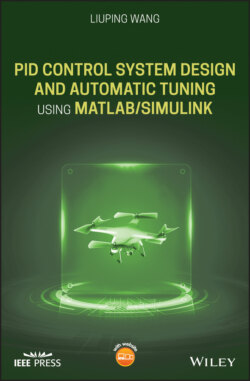Читать книгу PID Control System Design and Automatic Tuning using MATLAB/Simulink - Liuping Wang - Страница 2
Table of Contents
Оглавление1 Cover
2 Preface
3 Acknowledgment
4 List of Symbols and Acronyms
5 About the Companion Website
6 1 Basics of PID Control 1.1 Introduction 1.2 PID Controller Structure 1.3 Classical Tuning Rules for PID Controllers 1.4 Model Based PID Controller Tuning Rules 1.5 Examples for Evaluations of the Tuning Rules 1.6 Summary 1.7 Further Reading Problems Notes
7 2 Closed-loop Performance and Stability 2.1 Introduction 2.2 Routh–Hurwitz Stability Criterion 2.3 Nyquist Stability Criterion 2.4 Control System Structures and Sensitivity Functions 2.5 Reference Following and Disturbance Rejection 2.6 Disturbance Rejection and Noise Attenuation 2.7 Robust Stability and Robust Performance 2.8 Summary 2.9 Further Reading Problems
8 3 Model-Based PID and Resonant Controller Design 3.1 Introduction 3.2 PI Controller Design 3.3 Model Based Design for PID Controllers 3.4 Resonant Controller Design 3.5 Feedforward Control 3.6 Summary 3.7 Further Reading Problems Notes
9 4 Implementation of PID Controllers 4.1 Introduction 4.2 Scenario of a PID Controller at work 4.3 PID Controller Implementation using the Position Form 4.4 PID Controller Implementation using the Velocity Form 4.5 Anti-windup Implementation using the Position Form 4.6 Anti-windup Mechanisms in the Velocity Form 4.7 Tutorial on PID Anti-windup Implementation 4.8 Dealing with Other Implementation Issues 4.9 Summary 4.10 Further Reading Problems
10 5 Disturbance Observer- Based PID and Resonant Controller 5.1 Introduction 5.2 Disturbance observer-Based PI Controller 5.3 Disturbance observer-Based PID Controller 5.4 Disturbance observer-Based Resonant Controller 5.5 Multi-frequency Resonant Controller 5.6 Summary 5.7 Further Reading Problems
11 6 PID Control of Nonlinear Systems 6.1 Introduction 6.2 Linearization of the Nonlinear Model 6.3 Case Study: Ball and Plate Balancing System 6.4 Gain Scheduled PID Control Systems 6.5 Summary 6.6 Further Reading Problems
12 7 Cascade PID Control Systems 7.1 Introduction 7.2 Design of a Cascade PID Control System 7.3 Cascade Control System for Input Disturbance Rejection 7.4 Cascade Control System for Actuator Nonlinearities 7.5 Summary 7.6 Further Reading Problems
13 8 PID Controller Design for Complex Systems 8.1 Introduction 8.2 PI Controller Design via Gain and Phase Margins 8.3 PID Controller Design using Two Frequency Points 8.4 PID Controller Design for Integrating Systems 8.5 Summary 8.6 Further Reading Problems
14 9 Automatic Tuning of PID Controllers 9.1 Introduction 9.2 Relay Feedback Control 9.3 Estimation of Frequency Response using the Fast Fourier Transform (FFT) 9.4 Estimation of Frequency Response Using the frequency sampling filter (FSF) 9.5 Monte-Carlo Simulation Studies 9.6 Auto-tuner Design for Stable Plant 9.7 Auto-tuner Design for a Plant with an Integrator 9.8 Summary 9.9 Further Reading Problems Note
15 10 PID Control of Multi-rotor Unmanned Aerial Vehicles 10.1 Introduction 10.2 Multi-rotor Dynamics 10.3 Cascade Attitude Control of Multi-rotor UAVs 10.4 Automatic Tuning of Attitude Control Systems 10.5 Summary 10.6 Further Reading Problems
16 Suggestions to Food for Thought Questions
17 Bibliography
18 Index
19 End User License Agreement
